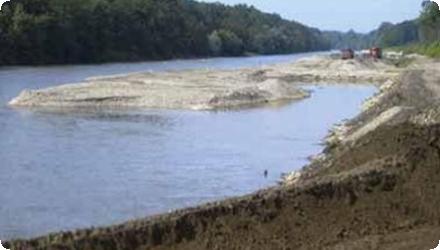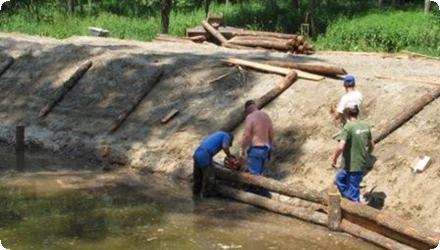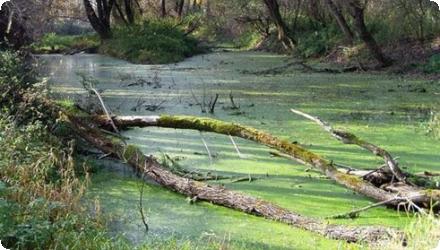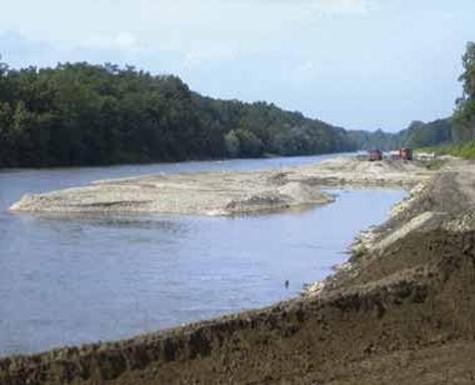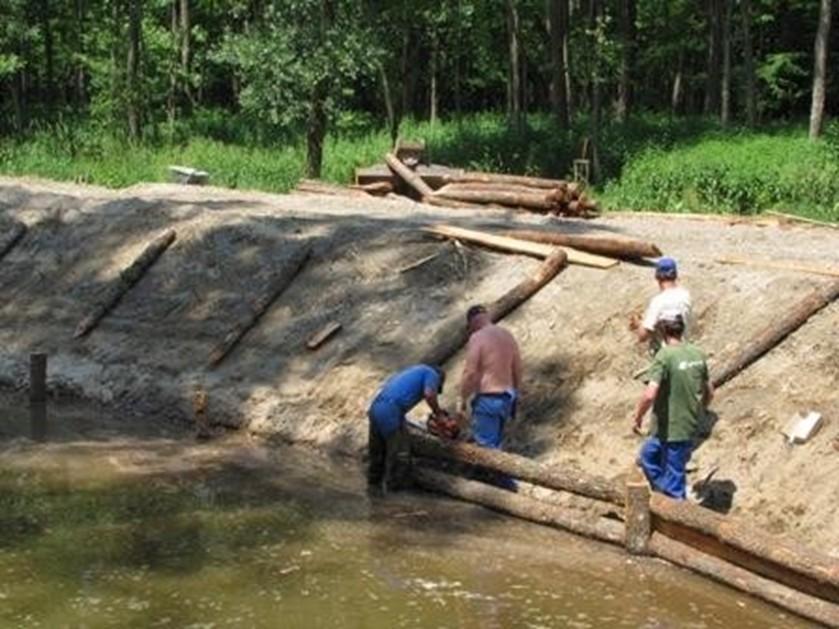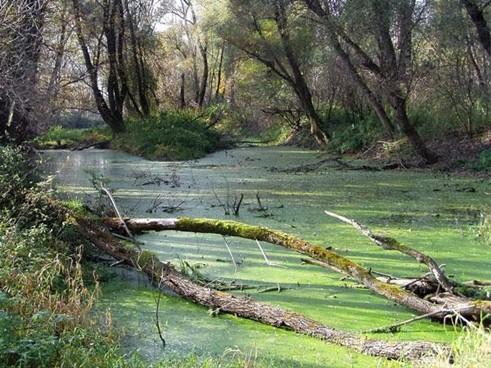Last update
2025
Summary
The BIOMURA project (LIFE06 NAT/SI/000066, 2006–2011) focused on conserving four Annex I habitat types along the Mura River in eastern Slovenia. Measures included reconnecting the main channel with side channels, securing adequate water intake at average and low flows, locally widening the riverbed, creating new side branches and backwaters, and sustainably maintaining alluvial forests. Works were implemented on the Bakovci–Mota reach and in villages such as Bunčani, Veržej, Melinci and others, with land purchase enabling habitat restoration. The project also established two information centres (Murska Sobota, Mota) and an educational trail in Veržej. These interventions improved hydromorphological processes, raised groundwater levels and enhanced habitats for riparian and endangered species, including amphibians, fish and birds. Funded by the LIFE programme, the Ministry of Environment and Spatial Planning, the Institute for Water of the Republic of Slovenia and partners, BIOMURA contributed to Natura 2000 site management and public awareness in the Pomurje region.
Position
Latitude
46.59138
Longitude
16.17805
Project
NWRM
National Id
Slovenia_01
Installation date
2011
Contact
REC
RBD code
SI_RBD_1
Transboundary
0
Photo gallery
Location of the project
The bed of the river Mura flows through NE Slovenia, whose area lies between the villages of Bakovci, Dokležovje, Ižakovci, Melinci, Bunčani, Veržej, Krapje and Mota.
NUTS Code
SK01 - Bratislavský kraj
Involved Partners
| Authority type | Authority name | Role | Comments |
|---|---|---|---|
Climate zone
cool temperate moist
Temperature
15
Annual rainfall range
600 - 900 mm
Runoff
350
Runoff coefficient range
0 - 0.2
Runoff range
300 - 450 mm
Imperviousness range
0 - 10%
Elevation range
189
Vegetation class
alluvial riparian forests (floodplain forests)
Water bodies: Ecological Status
Good
Water bodies: Chemical Status
Failing to achieve good
Project scale
Meso
Project scale specification
The area covered by the project has a surface of 15.2 km2 and is part of the Natura 2000. The area lies between the villages of Bakovci, Dokležovje, Ižakovci, Melinci, Bunčani, Veržej, Krapje and Mota.
Performance timescale
5 - 10 years
Project area
4024
Size
8,30000019073486
Size unit
km
Lifespan
50
Design capacity description
Conservation status of 1.200 ha of floodplain forests, 1.500 m of side channels and 5.000 m2 of oxbows will be reached and forest areas around 2 ha of oxbow lakesand along 5.000 m of side channels improved.
Removal of 9990 m3 of bank protections, an area of 1.7 ha for the gravel feeding was established. Two rock-fill
riffles were also established. At two locations a total of 5 070 m sidechannels were improved. Clearing of trees and shrubs was carried out on 27 000 m2 and oxbow lakes, overgrown with vegetation and sediment, were cleaned (more than 13 000 m3) .
Removal of 9990 m3 of bank protections, an area of 1.7 ha for the gravel feeding was established. Two rock-fill
riffles were also established. At two locations a total of 5 070 m sidechannels were improved. Clearing of trees and shrubs was carried out on 27 000 m2 and oxbow lakes, overgrown with vegetation and sediment, were cleaned (more than 13 000 m3) .
The measures undertaken depended on the knowledge of natural processes and encroachments upon the river habitat made in the past.
Although the Mura River has been straightened and the meanders cut-across, leaving behind oxbows, parts of the old channel are still recharged by the river, precipitation and groundwater. The processes of more relaxed, less controlled dynamics of the water flow, with a more frequent and easily spotted bank erosion, natural sediment transport and deposition, frequent flooding, river branches and oxbows, are especially present downstream of Veržej. The Mura river space in Slovenia, and at the reach bordering Croatia, is therefore among the richest ecosystems in Slovenia.
Although the Mura River has been straightened and the meanders cut-across, leaving behind oxbows, parts of the old channel are still recharged by the river, precipitation and groundwater. The processes of more relaxed, less controlled dynamics of the water flow, with a more frequent and easily spotted bank erosion, natural sediment transport and deposition, frequent flooding, river branches and oxbows, are especially present downstream of Veržej. The Mura river space in Slovenia, and at the reach bordering Croatia, is therefore among the richest ecosystems in Slovenia.
The biggest threat to this project is the project of hydropower stations construction on Mura river which is pushed by the investor Dravske elektrarne. In case of the future implementation of these power plants our best practice BIOMURA wills potentially be endangered or even destroyed and during the construction the water level was often too high, the work was interrupted for a few times.
Former wetland with a high biodiversity value
Positive influence effectiveness
Presence of former wetlands with a high biodiversity value
Negative influence effectiveness
Threat : project of hydropower stations construction on Mura river which is pushed by the investor Dravske Elektrarne. In case of the future implementation of these power plants our best practice BIOMURA wills potentially be endangered or even destroyed.
Total cost
€ 1,991,567
Costs total information
Land acquisition and value: 61800 € Thirteen purchase contracts for 26 parcels, 35663 m2 large.
Costs incurred from the start date to 31/10/2011
Costs incurred from the start date to 31/10/2011
Costs investment
1975519
Costs investment information
Total budget
Costs land acquisition unit
€ (total value)
Economic costs other annual
9000
Financing authorities
Type of funding
EU-funds: LIFE+
Comments
LIFE Nature program
Type of funding
National funds
Type of funding
National funds
Type of funding
Other
Compensations
0
Policy context
The reason for the project was high biodiversity value of the Mura
River in Slovenia. In 2004 a large part of it has been declared the
Natura 2000 site (SPA Mura SI5000010 and pSCA Mura SI3000215). It is crucial that proper water management and management of forest and agricultural areas are implemented to stop ecological deterioration and to support existing biodiversity value.
Intensive water use, activities in the river and riverside space and the change of land use in the Mura River catchment (chain of hydropower plants on the Mura in Austria, flood protection structures and facilities, water supply, management of agricultural land, urban development) have considerably altered the river space. Most of all, they affect the bed-load discharge and processes of self-formation of the river space in Slovenia. At the border between Slovenia and Austria, the river bed of the Mura River has deepened by as much as 1.5 m in the last decades (by 33 cm on average), and there is a trend of slow deepening of the river bottom downstream of Petanjci and change of hydrological features of the Mura wetlands. Flood events occur less often and the low flow periods are longer, resulting in the gradual drying-out of the alluvial forests along the Mura. The water dynamics in oxbows, side branches and on the ground is becoming less diverse. The creative power of water, needed for operation of such a habitat structure, is diminishing. With improper management of forest and agricultural areas the ecological habitat conditions of these wetlands are deteriorating.
River in Slovenia. In 2004 a large part of it has been declared the
Natura 2000 site (SPA Mura SI5000010 and pSCA Mura SI3000215). It is crucial that proper water management and management of forest and agricultural areas are implemented to stop ecological deterioration and to support existing biodiversity value.
Intensive water use, activities in the river and riverside space and the change of land use in the Mura River catchment (chain of hydropower plants on the Mura in Austria, flood protection structures and facilities, water supply, management of agricultural land, urban development) have considerably altered the river space. Most of all, they affect the bed-load discharge and processes of self-formation of the river space in Slovenia. At the border between Slovenia and Austria, the river bed of the Mura River has deepened by as much as 1.5 m in the last decades (by 33 cm on average), and there is a trend of slow deepening of the river bottom downstream of Petanjci and change of hydrological features of the Mura wetlands. Flood events occur less often and the low flow periods are longer, resulting in the gradual drying-out of the alluvial forests along the Mura. The water dynamics in oxbows, side branches and on the ground is becoming less diverse. The creative power of water, needed for operation of such a habitat structure, is diminishing. With improper management of forest and agricultural areas the ecological habitat conditions of these wetlands are deteriorating.
Community involvment
Yes
Design consultation activity
| Activity stage | Name | Key issues | Comments |
|---|---|---|---|
|
Workshops
|
3 local (15th May 2007 in Ljutomer, 30th November 2009 in Mota and 17th November 2010 in Doklezovje) and 2 regional (4th June 2007 in Muska Sobota and 12th October 2011 in Mota)
|
||
|
Biomura newsletter
|
10 Issues were published, 5 leaflets, DVD
|
||
|
Information Centre
|
Information centre with educational trail opened and 7 information pan
|
Policy target
| Target purpose |
|---|
|
Improved Biodiversity
|
|
Groundwater Recharge
|
Target Remarks
The activities of the BIOMURA project aimed at improvement of growing conditions for 4 habitats from the Habitats Directive: Riparian mixed forests of Quercus robur, Ulmus laevis and Ulmus minor, Fraxinus excelsior or Fraxinus angustifolia, along the great rivers (Ulmenion minoris); Water courses of plain to montane levels with the Ranunculion fluitantis and CallitrichoBatrachion vegetation ; Hydrophilous tall herb fringe communities of plains and of the montane to alpine levels; Alluvial forests with Alnus glutinosa and Fraxinus excelsior (Alno-Padion, Alnion incanae, Salicion albae).
The conservation of targeted species for more than a third of the Natura 2000 qualification species on the Mura river should be ensured. Targeted species from that Annex II to the Habitats Directive include: 1 butterfly species (Callimorpha quadripunctaria), 1 amphibian species (Bombina bombina), 1 dragonfly species (Ophiogomphus cecilia) and 5 fish species (Misgurnus fossilis, Rhodeus sericeus amarus, Gymnocephalus schraetzer,
Umbra krameri, Aspius aspius). Also, it is assumed that the living conditions of 29 other species of birds, butterflies, dragonflies, amphibians, reptiles and mammals improved.
The conservation of targeted species for more than a third of the Natura 2000 qualification species on the Mura river should be ensured. Targeted species from that Annex II to the Habitats Directive include: 1 butterfly species (Callimorpha quadripunctaria), 1 amphibian species (Bombina bombina), 1 dragonfly species (Ophiogomphus cecilia) and 5 fish species (Misgurnus fossilis, Rhodeus sericeus amarus, Gymnocephalus schraetzer,
Umbra krameri, Aspius aspius). Also, it is assumed that the living conditions of 29 other species of birds, butterflies, dragonflies, amphibians, reptiles and mammals improved.
Policy pressure
| Pressure directive | Relevant pressure |
|---|---|
|
WFD identified pressure
|
3.1 Abstraction – Agriculture
|
|
WFD identified pressure
|
3.2 Abstraction – Public Water Supply
|
|
WFD identified pressure
|
4.1.1 Physical alteration of channel/bed/riparian area/shore of water body for flood protection
|
|
WFD identified pressure
|
4.1.2 Physical alteration of channel/bed/riparian area/shore of water body for agriculture
|
Pressures remarks
Intensive water use, activities in the river and riverside space and the change of land use in the Mura River catchment (chain of hydropower plants on the Mura in Austria, flood protection structures and facilities, water supply, management of agricultural land, urban development) have considerably altered the river space.
Policy impact
| Impact directive | Relevant impact |
|---|---|
|
WFD identified impact
|
Ecological status
|
|
WFD identified impact
|
Alterations in discharge amount due to the uncontrolled water abstraction (e-flow)
|
|
Floods Directive identified impact
|
Water body status
|
Requirement directive
| Requirement directive | Specification |
|---|---|
|
WFD-achievement of good ecological status
|
Good ecological status and international collaboration
|
|
Floods Directive-mitigating Flood Risk
|
Flood protection and good ecological status
|
|
The Birds and Habitat Directives
|
Policy challenges requirements
RBMP of Danube River District
Contractual arrangements
1
| Arrangement type | Responsibility | Role | Name | Comments |
|---|---|---|---|---|
|
Agreement with the Ministry of the Environment and Spatial Planning
|
Part of wider plan
0
Wider plan type
| Wider plan type | Wider plan focus | Name | Comments |
|---|
monitoring of species and habitats was carried out during and after implementation by the Institute for Water of the Republic of Slovenia (IzVRS) and the Institute for Nature Conservation (ZRSVN)
The BIOMURA project monitored key biodiversity indicators to assess the success of restoration. Parameters included the presence, abundance, and breeding success of target bird species (Annex I Birds Directive), amphibian populations in restored and created backwaters, and fish community composition in reconnected side channels. Habitat structure, vegetation composition in floodplain forests, and the physical condition of newly excavated side branches and backwaters were also assessed. The monitoring aimed to detect changes in habitat quality, connectivity between the main river and side arms, and the response of priority species to hydromorphological improvements.
Maintenance
sustainable maintenance of alluvial forests and side channels was part of the project, including periodic clearing of vegetation and debris in side arms, and preservation of newly created habitats
Catchment outlet
Monitoring after many prior field inspections
Conservation of natural values and biodiversity will sustain if not enhance ground and surface water regimes in their dynamic character and connectivity.
Wetland ecosystem services such are fish stocks, groundwater for human consumption, wood stocks and biomass will become even more important for local and regional community. Restoration and rehabilitation works in the project area are offering job opportunities for local people and providing long-term opportunities for creation of trails, observation facilities, information center, education points and paths. Development of a sustainable tourism is an option and source of local employment and income increase in the Pomurje region in the future. The project has also become a strong counterpart to the idea of electricity production on the Mura River upstream.
Information on increased water storage
Increase in the volume of retained water due to the connectivity between the main river and side channels and introduction of higher river morphological structure in the river bed (erosion banks, gravel bars, river islands) and flood forest.
Information on Reducing flood risks, quantity
Local widening of the channel leaving space for flooding
Information on Restoring hydraulic connections
Connection of the main channel of the Mura River with side channels and abandoned oxbows with the main channel of Mura. Creation of favourable conditions to meet the needs of wetland and river ecology, which enables high biodiversity of the river Mura.
e.g., a 550 m new branch connected to the Besnica side arm; two chutes (drče) were built on the Mura; ~260 m of bank protection was removed near Bakovci to allow lateral widening; several backwaters (mrtvice) were deepened/created.
e.g., a 550 m new branch connected to the Besnica side arm; two chutes (drče) were built on the Mura; ~260 m of bank protection was removed near Bakovci to allow lateral widening; several backwaters (mrtvice) were deepened/created.
Water quality overall improvements
N/A info
Soil quality overall soil improvements
N/A info
1
Fish. 18 species documented in Besnica (out of ~40 native species in the Mura); presence of several threatened species (e.g., Rhodeus sericeus amarus, Leuciscus souffia [“navadna nežica”], Romanogobio vladykovi [“beloplavuti globoček”]—Slovene common names as listed). Side arms favor lentic/slow-water assemblages; strictly rheophilic targets remain in the main channel.
Amphibians. 11 species recorded 2007–2011; all renatured branches became important spawning sites, with immediate response (egg-mass counts, pairs, and individuals tracked at Bunčani, Veržej, Dokležovje).
Birds & forests. Very high densities of Middle Spotted Woodpecker and Collared Flycatcher in willow-dominated stands; actions expected to promote kingfisher, sand martin, and little ringed plover via eroding banks and gravel bars. (Qualitative/relative; no numeric densities given.)
Amphibians. 11 species recorded 2007–2011; all renatured branches became important spawning sites, with immediate response (egg-mass counts, pairs, and individuals tracked at Bunčani, Veržej, Dokležovje).
Birds & forests. Very high densities of Middle Spotted Woodpecker and Collared Flycatcher in willow-dominated stands; actions expected to promote kingfisher, sand martin, and little ringed plover via eroding banks and gravel bars. (Qualitative/relative; no numeric densities given.)
Ecosystem impact climate regulation
Not relevant for the specific application
Information on Ecosystem provisioning services
Ecosystem services such are fish stocks, groundwater for human consumption, wood stocks and biomass will become even more important for local and regional community
Key lessons
One of the main lessons from BIOMURA is that restoring connectivity between the main river channel and its side arms can quickly generate ecological benefits. The excavation of new branches, reconnection of old meanders, and removal of bank protection created diverse hydraulic conditions that were rapidly colonised by amphibians, fish, and riparian vegetation. This confirms the effectiveness of targeted hydromorphological interventions for biodiversity recovery in regulated lowland rivers.
Another lesson is the importance of land acquisition in enabling restoration. Purchasing key parcels along the Mura allowed works to proceed without conflicting with agricultural land use, and secured the long-term management of restored habitats. Without this, maintaining restored structures and forest stands would have been much more challenging.
The project also demonstrated that a good knowledge and coordination of the tasks of each stakeholder is essential for completing works without serious problems. BIOMURA benefited from good organisation, mutual respect between partners, and joint engagement in preparing outreach materials such as a film, workshops, and field visits. This partnership model is considered successful and should be further developed in other environmental projects in Slovenia.
Thanks to the project, the local community recognised that nature is important and that both the European Commission and national authorities care about their Mura. Public engagement through information centres and educational trails fostered this connection, which is crucial for sustaining support in the long term.
Finally, BIOMURA highlighted the limits of local restoration in the face of larger-scale pressures. While side arms were rewatered and habitats improved locally, long-term issues such as regional groundwater decline and sediment deficit, driven by upstream regulation, remain unresolved. This underlines that site-level actions need to be integrated into basin-wide management to achieve lasting hydrological improvements.
Another lesson is the importance of land acquisition in enabling restoration. Purchasing key parcels along the Mura allowed works to proceed without conflicting with agricultural land use, and secured the long-term management of restored habitats. Without this, maintaining restored structures and forest stands would have been much more challenging.
The project also demonstrated that a good knowledge and coordination of the tasks of each stakeholder is essential for completing works without serious problems. BIOMURA benefited from good organisation, mutual respect between partners, and joint engagement in preparing outreach materials such as a film, workshops, and field visits. This partnership model is considered successful and should be further developed in other environmental projects in Slovenia.
Thanks to the project, the local community recognised that nature is important and that both the European Commission and national authorities care about their Mura. Public engagement through information centres and educational trails fostered this connection, which is crucial for sustaining support in the long term.
Finally, BIOMURA highlighted the limits of local restoration in the face of larger-scale pressures. While side arms were rewatered and habitats improved locally, long-term issues such as regional groundwater decline and sediment deficit, driven by upstream regulation, remain unresolved. This underlines that site-level actions need to be integrated into basin-wide management to achieve lasting hydrological improvements.
Success factor(s)
| Success factor type | Success factor role | Comments | Order |
|---|---|---|---|
|
Attitude of relevant stakeholders
|
main factor
|
<p>Good organization between stakeholders and assigned activities</p>
|
1
|
|
Successful coordination between authorities
|
main factor
|
2
|
Driver
| Driver type | Driver role | Comments | Order |
|---|---|---|---|
|
Legal obligations
|
main driver
|
Habitats Directive and Birds Directive
|
1
|
Transferability
The BIOMURA approach is transferable to other regulated lowland rivers where side arms can be reconnected and habitats restored. Success depends on securing land rights, ensuring stakeholder coordination, and combining ecological works with community engagement. Care is needed to address wider basin-scale pressures (e.g. sediment deficit, groundwater decline) so local gains are not undermined by upstream or regional impacts.
Basin characteristics influence
The bed of the river Mura that flows through NE Slovenia is well preserved, especially in the middle and lower stream, where it is characterized by embankment erosion, deposition of the sand, flooding and side-channels.
English
